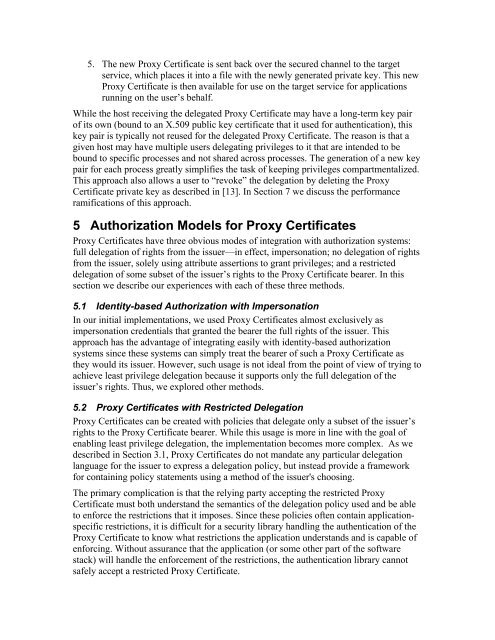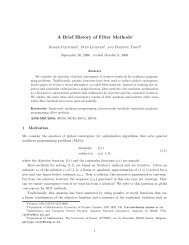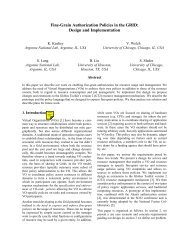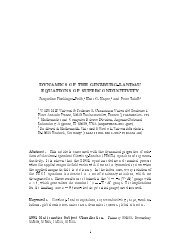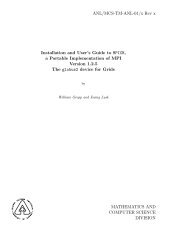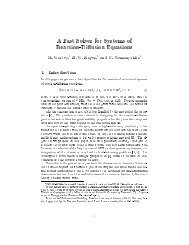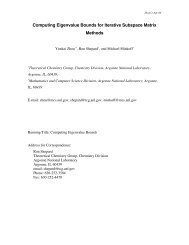X.509 Proxy Certificates for Dynamic Delegation - tp.mcs.anl.gov ...
X.509 Proxy Certificates for Dynamic Delegation - tp.mcs.anl.gov ...
X.509 Proxy Certificates for Dynamic Delegation - tp.mcs.anl.gov ...
You also want an ePaper? Increase the reach of your titles
YUMPU automatically turns print PDFs into web optimized ePapers that Google loves.
5. The new <strong>Proxy</strong> Certificate is sent back over the secured channel to the targetservice, which places it into a file with the newly generated private key. This new<strong>Proxy</strong> Certificate is then available <strong>for</strong> use on the target service <strong>for</strong> applicationsrunning on the user’s behalf.While the host receiving the delegated <strong>Proxy</strong> Certificate may have a long-term key pairof its own (bound to an <strong>X.509</strong> public key certificate that it used <strong>for</strong> authentication), thiskey pair is typically not reused <strong>for</strong> the delegated <strong>Proxy</strong> Certificate. The reason is that agiven host may have multiple users delegating privileges to it that are intended to bebound to specific processes and not shared across processes. The generation of a new keypair <strong>for</strong> each process greatly simplifies the task of keeping privileges compartmentalized.This approach also allows a user to “revoke” the delegation by deleting the <strong>Proxy</strong>Certificate private key as described in [13]. In Section 7 we discuss the per<strong>for</strong>manceramifications of this approach.5 Authorization Models <strong>for</strong> <strong>Proxy</strong> <strong>Certificates</strong><strong>Proxy</strong> <strong>Certificates</strong> have three obvious modes of integration with authorization systems:full delegation of rights from the issuer—in effect, impersonation; no delegation of rightsfrom the issuer, solely using attribute assertions to grant privileges; and a restricteddelegation of some subset of the issuer’s rights to the <strong>Proxy</strong> Certificate bearer. In thissection we describe our experiences with each of these three methods.5.1 Identity-based Authorization with ImpersonationIn our initial implementations, we used <strong>Proxy</strong> <strong>Certificates</strong> almost exclusively asimpersonation credentials that granted the bearer the full rights of the issuer. Thisapproach has the advantage of integrating easily with identity-based authorizationsystems since these systems can simply treat the bearer of such a <strong>Proxy</strong> Certificate asthey would its issuer. However, such usage is not ideal from the point of view of trying toachieve least privilege delegation because it supports only the full delegation of theissuer’s rights. Thus, we explored other methods.5.2 <strong>Proxy</strong> <strong>Certificates</strong> with Restricted <strong>Delegation</strong><strong>Proxy</strong> <strong>Certificates</strong> can be created with policies that delegate only a subset of the issuer’srights to the <strong>Proxy</strong> Certificate bearer. While this usage is more in line with the goal ofenabling least privilege delegation, the implementation becomes more complex. As wedescribed in Section 3.1, <strong>Proxy</strong> <strong>Certificates</strong> do not mandate any particular delegationlanguage <strong>for</strong> the issuer to express a delegation policy, but instead provide a framework<strong>for</strong> containing policy statements using a method of the issuer's choosing.The primary complication is that the relying party accepting the restricted <strong>Proxy</strong>Certificate must both understand the semantics of the delegation policy used and be ableto en<strong>for</strong>ce the restrictions that it imposes. Since these policies often contain applicationspecificrestrictions, it is difficult <strong>for</strong> a security library handling the authentication of the<strong>Proxy</strong> Certificate to know what restrictions the application understands and is capable ofen<strong>for</strong>cing. Without assurance that the application (or some other part of the softwarestack) will handle the en<strong>for</strong>cement of the restrictions, the authentication library cannotsafely accept a restricted <strong>Proxy</strong> Certificate.


